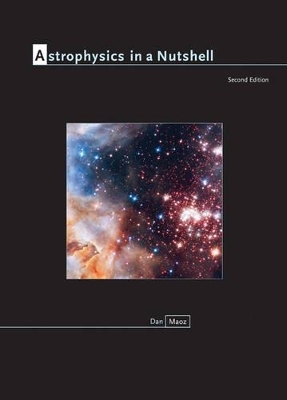
Astrophysics in a Nutshell
Princeton University Press (Verlag)
978-0-691-16479-3 (ISBN)
Generously illustrated, it covers the essentials of modern astrophysics, emphasizing the common physical principles that govern astronomical phenomena, and the interplay between theory and observation, while also introducing subjects at the forefront of modern research, including black holes, dark matter, dark energy, and gravitational lensing. In addition to serving as a course textbook, Astrophysics in a Nutshell is an ideal review for a qualifying exam and a handy reference for teachers and researchers.
* The most concise and current astrophysics textbook for science majors--now expanded and fully updated with the latest research results* Contains a broad and well-balanced selection of traditional and current topics* Uses simple, short, and clear derivations of physical results* Trains students in the essential skills of order-of-magnitude analysis* Features a new chapter on extrasolar planets, including discovery techniques* Includes new and expanded sections and problems on the physics of shocks, supernova remnants, cosmic-ray acceleration, white dwarf properties, baryon acoustic oscillations, and more* Contains instructive problem sets at the end of each chapter* Solutions manual (available only to professors)
Dan Maoz is the George S. Wise Professor at Tel-Aviv University, where he chairs the School of Physics and Astronomy.
Preface xii Constants and Units xvii Chapter 1: Introduction 1 1.1 Observational Techniques 2 Problems 8 Chapter 2: Stars: Basic Observations 10 2.1 Review of Blackbody Radiation 10 2.2 Measurement of Stellar Parameters 14 2.3 The Hertzsprung-Russell Diagram 26 Problems 28 Chapter 3: Stellar Physics 30 3.1 Hydrostatic Equilibrium and the Virial Theorem 31 3.2 Mass Continuity 35 3.3 Radiative Energy Transport 35 3.4 Energy Conservation 40 3.5 The Equations of Stellar Structure 41 3.6 The Equation of State 42 3.7 Opacity 44 3.8 Scaling Relations on the Main Sequence 45 3.9 Nuclear Energy Production 47 3.10 Nuclear Reaction Rates 52 3.11 Solution of the Equations of Stellar Structure 57 3.12 Convection 57 Problems 60 Chapter 4: Stellar Evolution and Stellar Remnants 64 4.1 Stellar Evolution 64 4.2 White Dwarfs 69 4.3 Supernovae and Neutron Stars 82 4.4 Pulsars 89 4.5 Black Holes 96 4.6 Interacting Binaries 99 Problems 109 Chapter 5: Star Formation and the Interstellar Medium 115 5.1 Cloud Collapse and Star Formation 115 5.2 H II Regions 122 5.3 Components of the Interstellar Medium 133 5.4 Shocks, Supernova Remnants, and Cosmic Rays 136 Problems 153 Chapter 6: Extrasolar Planets 157 6.1 Planet Detection Methods 158 6.2 Planetary System Occurrence and Architecture 175 6.3 Planet Formation and Evolution 178 6.4 Habitable Zones and the Search for Life 180 Problems 182 Chapter 7: The Milky Way and Other Galaxies 185 7.1 Structure of the Milky Way 185 7.2 Galaxy Demographics 200 7.3 Active Galactic Nuclei and Quasars 203 7.4 Groups and Clusters of Galaxies 208 Problems 212 Chapter 8: Cosmology: Basic Observations 215 8.1 The Olbers Paradox 215 8.2 Extragalactic Distances 216 8.3 Hubble's Law 223 8.4 Age of the Universe from Cosmic Clocks 225 8.5 Isotropy of the Universe 226 Problems 227 Chapter 9: Big Bang Cosmology 228 9.1 The Friedmann-Lemaitre-Robertson-Walker Metric 228 9.2 The Friedmann Equations 231 9.3 History and Future of the Universe 234 9.4 A Newtonian Derivation of the Friedmann Equations 240 9.5 Dark Energy and the Accelerating Universe 242 Problems 245 Chapter 10: Tests and Probes of Big Bang Cosmology 247 10.1 Cosmological Redshift and Hubble's Law 247 10.2 The Cosmic Microwave Background 251 10.3 Anisotropy of the Microwave Background 255 10.4 Baron Acoustic Oscillations 261 10.5 Nucleosynthesis of the Light Elements 263 10.6 Quasars and Other Distant Sources as Cosmological Probes 266 Problems 269 Appendix 275 Index 239
| Erscheinungsdatum | 29.02.2016 |
|---|---|
| Reihe/Serie | In a Nutshell |
| Zusatzinfo | 21 halftones. 77 line illus. |
| Verlagsort | New Jersey |
| Sprache | englisch |
| Maße | 178 x 254 mm |
| Gewicht | 794 g |
| Themenwelt | Schulbuch / Wörterbuch ► Lexikon / Chroniken |
| Naturwissenschaften ► Physik / Astronomie ► Astronomie / Astrophysik | |
| ISBN-10 | 0-691-16479-7 / 0691164797 |
| ISBN-13 | 978-0-691-16479-3 / 9780691164793 |
| Zustand | Neuware |
| Haben Sie eine Frage zum Produkt? |
aus dem Bereich


